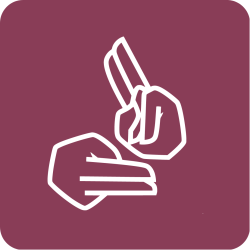Did you know that there are over 72 million people around the world using sign language? And that there are more than 300 sign languages?
Perhaps you’re thinking:
“Is there not just one single universal Sign Language that everyone can use?”
“Why not? This would be so much easier.”
These thoughts only really make sense if you are picturing sign languages as a kind of helper/aid by hearing people to deaf or hard of hearing people.
So, let’s take a moment to think about these statements and learn more about the 300 sign languages that are used around the world.
“Never-ending language”
Sign languages, like spoken words, have many different forms and the sign languages are different from nation to nation. In the spoken language world we have regional accents and this is very much the same with Sign Language, the signs used in the north of the country are different from those used in the south. This alone shows how complex the language can be because the person learning the language needs to adjust to different regions and the signs used. You could say it’s a never-ending language to learn – those that take on learning Sign Language will always be learning new vocabulary.
Let’s take a look at some of the Sign Languages used around the world and their similarities:
America
Around the world the Deaf communities develop sign languages for where they live, this is unique to them. For example, although the UK and America use spoken English the Sign Languages used vary significantly – British Sign Language is a two-handed alphabet and American Sign Language has a one-handed alphabet.
Australia & New Zealand
British, Australian and New Zealand Sign Language (BANZSL), is the language of which British Sign Language (BSL), Auslan and New Zealand Sign Language (NZSL) may be considered dialects. These three languages may be considered dialects of a single language (BANZSL) due to their use of the same grammar, manual alphabet, and the high degree of lexical overlap. The term BANZSL was coined by Trevor Johnston and Adam Schembri – such a bonus for those learning BSL because I don’t know about you but I would be happy to visit Australia or New Zealand!
Europe & UK
Ireland has its own sign language (ISL), which is derived from French Sign Language but there are some similarities with BSL.
French Sign Language (LSF) is one of the earliest European sign languages to gain acceptance by educators. LSF influenced other sign languages such as ASL, ISL, Russian Sign Language (RSL).
In the UK, British Sign Language is the most commonly used sign language. Being a part of the deaf community makes you feel a part of something bigger than yourself. You’re part of a team; the use of British Sign Language (BSL) creates a shared culture; community and life experience. No matter what country you reside in, Sign Language enables deaf people to freely communicate and feel part of a worldwide community they belong in.
Interpreting
Deaf people experience communication barriers daily. At terptree we provide interpreting and translation services and we have an extensive list of communication professionals on our database.
We only use qualified and registered communication professionals. It is important that the Interpreter understands the subtle differences between BSL dialects and the complexity of the language.
Check out these other posts...

The Importance of Student Choice in NMH Support
When recommending support for Deaf students, one of the most important principles to uphold is student choice. Every student has different communication preferences, study needs,

How to Manage Emergency Situations Involving Deaf Customers: A Practical Guide for Teams on the Ground and in Leadership
When an emergency strikes, whether it’s a fire alarm, evacuation, or medical incident – clear, timely communication can make all the difference. But for Deaf

Tailoring Inclusivity for Different Work Environments
Creating an inclusive workplace isn’t about applying one blanket solution, it’s about understanding people, spaces, and how the two interact. For Deaf employees, the barriers




